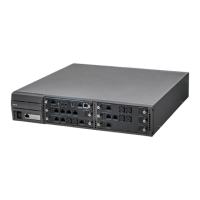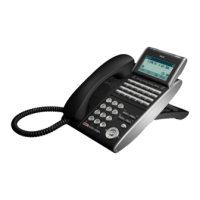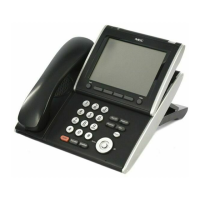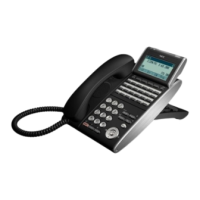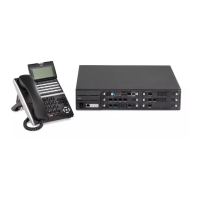



Do you have a question about the NEC SL1000 and is the answer not in the manual?
Explains the call indicator lamp and the alphanumeric display on the phone.
Details the purpose and operation of various keys like Hold, Speaker, Mute, and navigation keys.
Describes how to use handsfree mode and automatic handsfree features.
Instructions for programming function keys for specific tasks or extensions.
Guide to assigning DSS or One-Touch keys for direct dialing or feature access.
Procedure for registering abbreviated dialing numbers and names.
Method for entering letters and characters using the dial pad keys.
How to place an outside call using quick access features.
Steps to place an outside call using access codes and trunk numbers.
Procedure for placing an intercom call by dialing the extension number.
Quick dialing for outside calls using stored numbers.
Making outside or intercom calls with a single key press.
How to redial the last dialed numbers.
Using Camp On and Callback when calls do not connect or are busy.
Setting and answering a message waiting indicator for notifications.
Checking, canceling, and clearing message waiting indicators.
How the system automatically redials a call if it fails.
Procedures for answering incoming calls from outside lines.
How to answer calls from internal extensions.
Methods for answering calls intended for other extensions.
How to hold calls, retrieve held calls, and hold exclusively.
Retrieving held outside calls and transferring calls to other extensions.
Setting the Do Not Disturb feature to block incoming calls.
Configuring call forwarding for immediate, busy, or no-answer conditions.
Setting call forwarding for busy, ring, or follow-me scenarios.
Instructions for setting up multi-party conference calls.
Viewing the history of incoming, missed, and dialed calls.
Reviewing a list of missed incoming calls.
Viewing a list of received incoming calls.
Reviewing the history of dialed outgoing calls.
Searching speed dial entries and initiating calls.
Instructions for recording an answering message using VRS.
How to listen to recorded VRS messages.
Procedure for deleting recorded VRS messages.
How to access and listen to voice messages left by callers.
Procedure for deleting voice messages.
Checking the current time, date, and station number.
Setting up function keys for voice mail access and features.
Verifying the programmed functions assigned to keys.
Steps to call your mailbox and navigate the main menu.
Overview of InMail features like listening, recording, and greetings.
Using the Voice Mail key to automatically play messages.
Following voice prompts to listen to messages in your mailbox.
Configuring the phone to forward all incoming calls to the voice mailbox.
Setting call forwarding when the phone is busy.
Setting call forwarding when there is no answer.
Configuring call forwarding for busy or no-answer conditions.
Procedure for accessing your mailbox from an external phone.
Method for leaving a quick message for another extension.
How to leave a message after calling an extension.
Explains the call indicator lamp and the alphanumeric display on the phone.
Details the purpose and operation of various keys like Hold, Speaker, Mute, and navigation keys.
Describes how to use handsfree mode and automatic handsfree features.
Instructions for programming function keys for specific tasks or extensions.
Guide to assigning DSS or One-Touch keys for direct dialing or feature access.
Procedure for registering abbreviated dialing numbers and names.
Method for entering letters and characters using the dial pad keys.
How to place an outside call using quick access features.
Steps to place an outside call using access codes and trunk numbers.
Procedure for placing an intercom call by dialing the extension number.
Quick dialing for outside calls using stored numbers.
Making outside or intercom calls with a single key press.
How to redial the last dialed numbers.
Using Camp On and Callback when calls do not connect or are busy.
Setting and answering a message waiting indicator for notifications.
Checking, canceling, and clearing message waiting indicators.
How the system automatically redials a call if it fails.
Procedures for answering incoming calls from outside lines.
How to answer calls from internal extensions.
Methods for answering calls intended for other extensions.
How to hold calls, retrieve held calls, and hold exclusively.
Retrieving held outside calls and transferring calls to other extensions.
Setting the Do Not Disturb feature to block incoming calls.
Configuring call forwarding for immediate, busy, or no-answer conditions.
Setting call forwarding for busy, ring, or follow-me scenarios.
Instructions for setting up multi-party conference calls.
Viewing the history of incoming, missed, and dialed calls.
Reviewing a list of missed incoming calls.
Viewing a list of received incoming calls.
Reviewing the history of dialed outgoing calls.
Searching speed dial entries and initiating calls.
Instructions for recording an answering message using VRS.
How to listen to recorded VRS messages.
Procedure for deleting recorded VRS messages.
How to access and listen to voice messages left by callers.
Procedure for deleting voice messages.
Checking the current time, date, and station number.
Setting up function keys for voice mail access and features.
Verifying the programmed functions assigned to keys.
Steps to call your mailbox and navigate the main menu.
Overview of InMail features like listening, recording, and greetings.
Using the Voice Mail key to automatically play messages.
Following voice prompts to listen to messages in your mailbox.
Configuring the phone to forward all incoming calls to the voice mailbox.
Setting call forwarding when the phone is busy.
Setting call forwarding when there is no answer.
Configuring call forwarding for busy or no-answer conditions.
Procedure for accessing your mailbox from an external phone.
Method for leaving a quick message for another extension.
How to leave a message after calling an extension.
| VoIP | Yes |
|---|---|
| Expandable | Yes |
| VoIP Protocols | SIP |
| Power Supply | 100-240V AC, 50/60Hz |
| Network Interfaces | 10/100BASE-T |
| Operating Temperature | 0°C to 40°C (32°F to 104°F) |
| Humidity | 10% to 90% non-condensing |
| Weight | 15.4 lbs |






